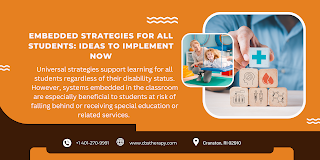Embedded Strategies for All Students: Ideas to Implement Now
Universal strategies support learning for all students regardless of their disability status. However, systems embedded in the classroom are especially beneficial to students at risk of falling behind or receiving special education or related services. Providing best practices to all of your students is a win-win for general and special education staff and, of course, students.
Flexible Seating
Many people picture elaborate chairs and spaces when the topic of flexible seating comes up. T-stools, rocking chairs, and swings built into classrooms are excellent but flexible seating doesn’t have to be complex! Allow your students to stand at their table, move to a different space, or lay on their bellies during read-aloud. Movement helps both children and adults focus (hence the popularity of the office sit-stand desk). Click here.
Positive Reinforcement
Positive reinforcement helps create a nurturing classroom environment and is a tool that encourages children to engage in appropriate behaviors. Positive reinforcement also builds up a child’s self-esteem. Give your students a high-five, recognize their hard work, or allow them to earn a fun activity. Use positive reinforcement often and with all of your students.
Use a Routine
Routines provide structure for a day with academics, social participation, lunch, breaks, and more. A transition is much smoother when a student is expecting it. Let your students know when there will be a change in the routine and remind them throughout the day. Post a schedule of the day where everyone can see it. Use picture images for young children and write the plan out for students who are confident readers.
Check-in
For student well-being to occur at school, an adult must connect with them. Touching base with them each day can foster a community of positive mental health. You can use the Zones of Regulation or other programs or even teach and provide language for them in the classroom. Make them feel comfortable sharing by using examples from your own life and validating that experiencing different emotions is okay. When appropriate, offer strategies such as deep breathing or movement to help your students feel their best, and feel supported.
Provide Extra Time
Some children can easily recognize and process sensory information in the world and then quickly recall information and figure out how to respond to a question, for example. For others, it takes longer. Giving extra time to all students offers everyone a chance to participate in the conversation. Especially after asking, “does anybody have questions?” try to pause for five to ten seconds.
Heavy Work
Sensory supports encompass a wide variety of strategies to support student learning. One popular activity, heavy work, targets the proprioceptive system to help students feel calm and regulated. Classroom jobs like pushing in or stacking chairs, wiping down tables or chalkboards, or carrying heavy books to the library all target the proprioceptive system. If any of your students are seeking movement, offer structured activities at recess. Include activities and games like wheelbarrow walking, hopscotch, four-square, climbing monkey bars, or climbing a hill. Embedded strategies aren’t just for children who receive special education or related services. Try these ideas to help all of your students be their best. For more information visit at https://cbstherapy.com/



Comments
Post a Comment